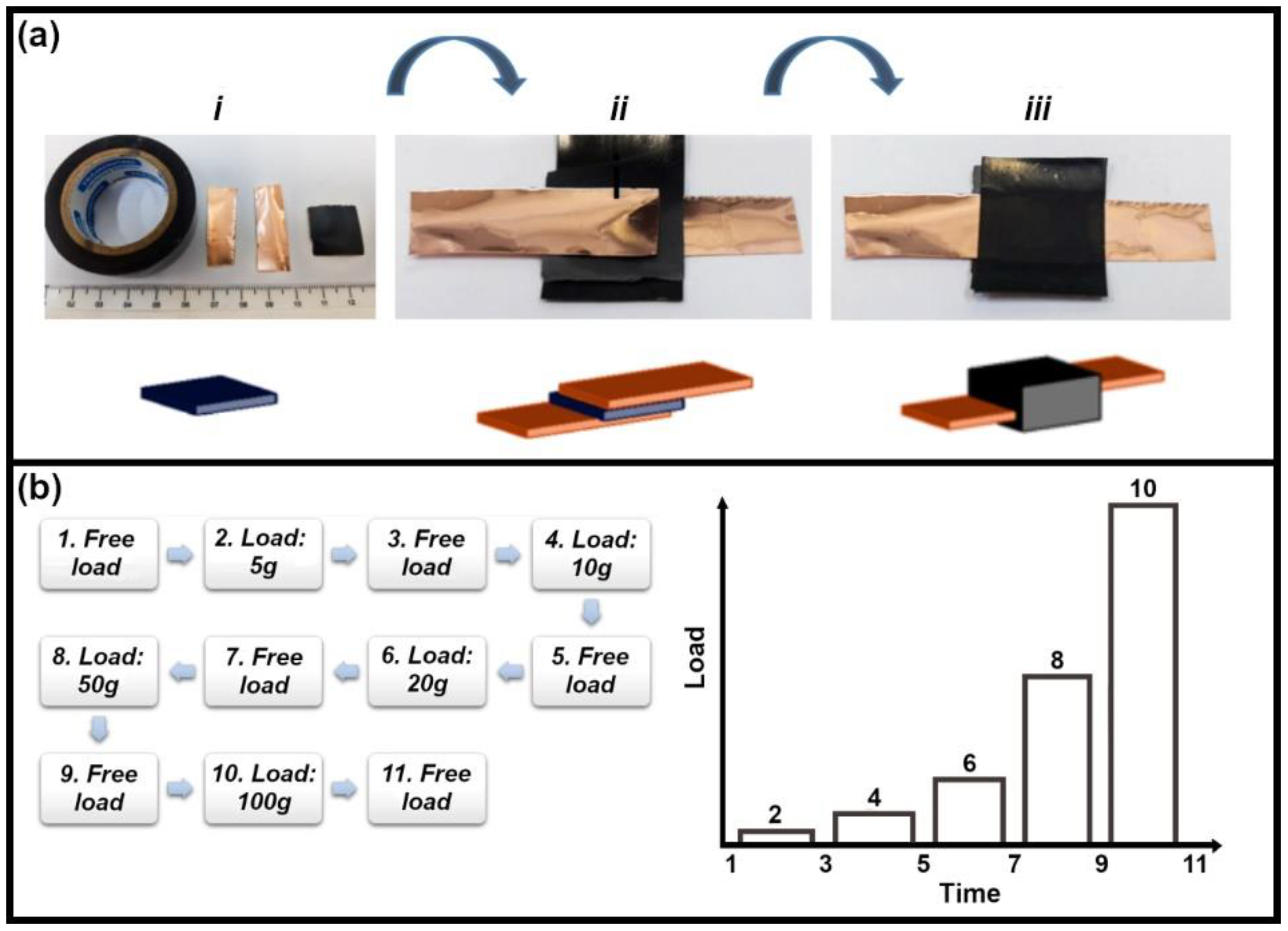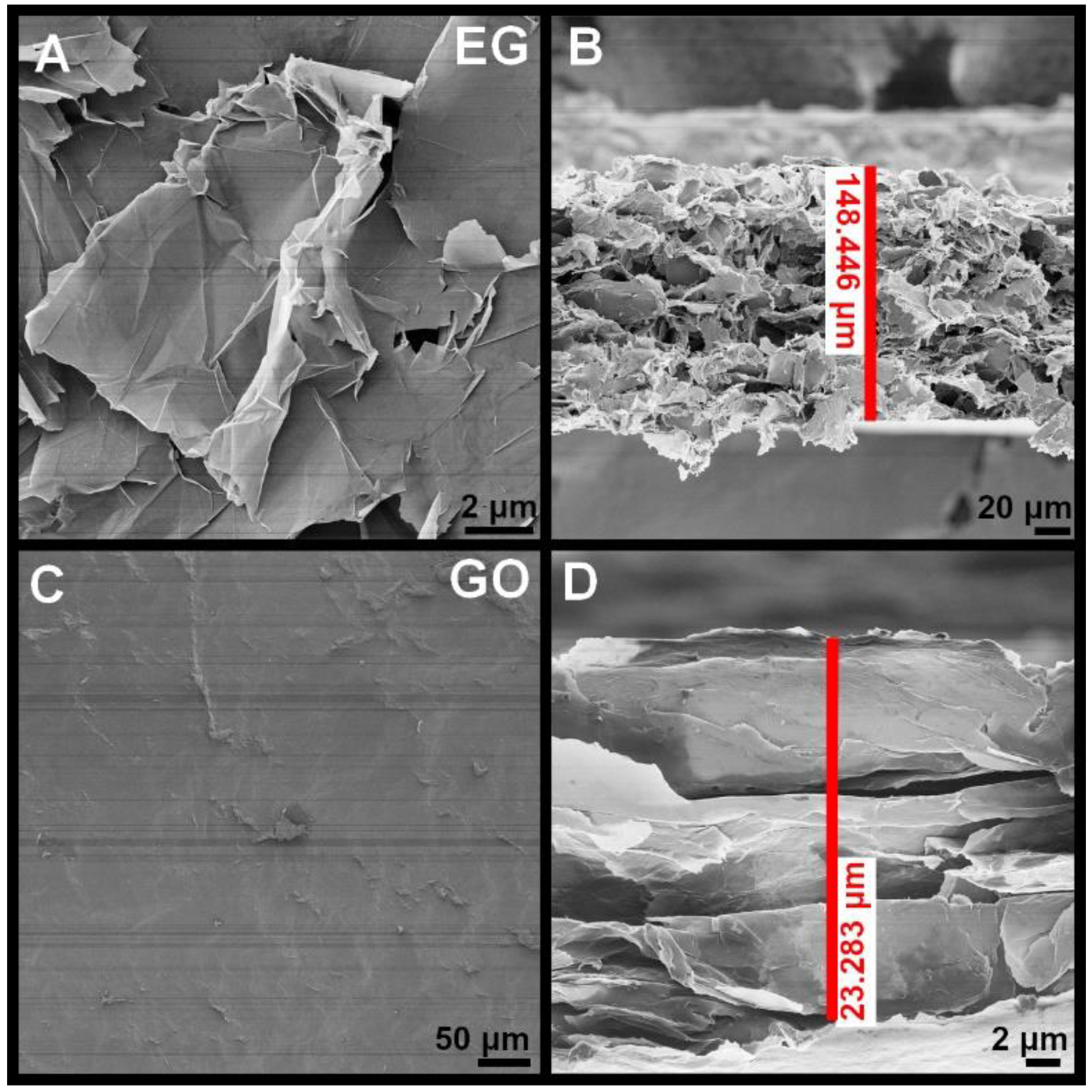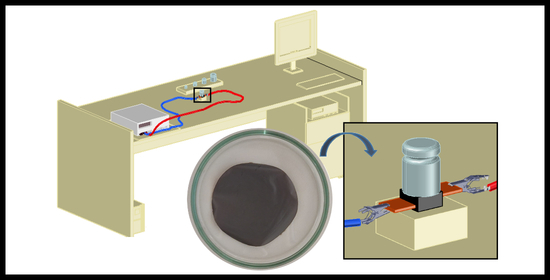Prototyping and Evaluation of Graphene-Based Piezoresistive Sensors
Abstract
:1. Introduction
2. Materials and Methods
- Graphene Papers
- Morphological Characterization of the Graphene Papers
- Electrical Characterization of the Graphene Papers
- Fabrication of the Prototypes
- Electrical–Mechanical Tests
- Variation of electrical current (and the corresponding variation of electrical resistance);
- Definition of the characteristic value of average electrical resistance for each applied mechanical load;
- Sensitivity of the sensor prototype, in terms of electrical resistance variation by applied load, (ΔR)/kPa.
3. Results and Discussion
3.1. Morphological Characterization
3.2. Electrical Characterization
3.3. Mechanical Test
4. Conclusions
Author Contributions
Funding
Conflicts of Interest
References
- Novoselov, K.S.; Geim, A.K.; Morozov, S.V.; Jiang, D.; Zhang, Y.; Dubonos, S.V.; Grigorieva, I.V.; Firsov, A.A. Electric field effect in atomically thin carbon films. Science 2004, 306, 666–669. [Google Scholar] [CrossRef] [PubMed] [Green Version]
- Smith, A.D.; Vaziri, S.; Niklaus, F.; Fischer, A.C.; Sterner, M.; Delin, A.; Östling, M.; Lemme, M.C. Pressure sensors based on suspended graphene membranes. Solid-State Electron. 2013, 88, 89–94. [Google Scholar] [CrossRef]
- Lee, C.; Wei, X.; Kysar, J.W.; Hone, J. Measurement of the elastic properties and intrinsic strength of monolayer graphene. Science 2008, 321, 385–388. [Google Scholar] [CrossRef] [PubMed]
- Pollard, A.J.; Clifford, C.A. Terminology: The first step towards international standardisation of graphene and related 2D materials. J. Mater. Sci. 2017, 52, 13685–13688. [Google Scholar] [CrossRef]
- Kwon, O.K.; Lee, J.H.; Kim, K.-S.; Kang, J.W. Developing ultrasensitive pressure sensor based on graphene nanoribbon: Molecular dynamics simulation. Phys. E Low-Dimens. Syst. Nanostruct. 2013, 47, 6–11. [Google Scholar] [CrossRef]
- Ma, J.; Jin, W.; Ho, H.L.; Dai, J.Y. High-sensitivity fiber-tip pressure sensor with graphene diaphragm. Opt. Lett. 2012, 37, 2493–2495. [Google Scholar] [CrossRef] [Green Version]
- Chun, S.; Kim, Y.; Jin, H.; Choi, E.; Lee, S.-B.; Park, W. A graphene force sensor with pressure-amplifying structure. Carbon 2014, 78, 601–608. [Google Scholar] [CrossRef]
- Habibi, M.; Darbari, S.; Rajabali, S.; Ahmadi, V. Fabrication of a graphene-based pressure sensor by utilising field emission behavior of carbon nanotubes. Carbon 2016, 96, 259–267. [Google Scholar] [CrossRef]
- Kazemzadeh, R.; Kim, W.S. Piezo-resistive Pressure Sensor Array with Photo-thermally Reduced Graphene Oxide. MRS Proc. 2015, 1798, mrss 15-2135590. [Google Scholar] [CrossRef]
- Vaka, M.; Bian, M.Z.; Nam, N.D. Highly sensitive pressure sensor based on graphene hybrids. Arab. J. Chem. 2020, 13, 1917–1923. [Google Scholar] [CrossRef]
- Geim, A.K.; Novoselov, K.S. The rise of graphene. Nat. Mater. 2007, 6, 183–191. [Google Scholar] [CrossRef] [PubMed]
- Rao, K.S.; Samyuktha, W.; Vardhan, D.V.; Naidu, B.G.; Kumar, P.A.; Sravani, K.G.; Guha, K. Design and sensitivity analysis of capacitive MEMS pressure sensor for blood pressure measurement. Microsyst. Technol. 2020, 26, 2371–2379. [Google Scholar] [CrossRef]
- Zhu, S.-E.; Ghatkesar, M.K.; Zhang, C.; Janssen, G.C.A.M. Graphene based piezoresistive pressure sensor. Appl. Phys. Lett. 2013, 102, 161904. [Google Scholar] [CrossRef] [Green Version]
- Zheng, Q.; Lee, J.-H.; Shen, X.; Chen, X.; Kim, J.-K. Graphene-based wearable piezoresistive physical sensors. Mater. Today 2020, 36, 158–179. [Google Scholar] [CrossRef]
- Jing, Z.; Zhang, Q.; Cheng, Y.; Ji, C.; Zhao, D.; Liu, Y.; Jia, W.; Pan, S.; Sang, S. Highly sensitive, reliable and flexible piezoresistive pressure sensors based on graphene-PDMS@ sponge. J. Micromech. Microeng. 2020, 30, 085012. [Google Scholar] [CrossRef]
- Huang, H.; Su, S.; Wu, N.; Wan, H.; Wan, S.; Bi, H.; Sun, L. Graphene-based sensors for human health monitoring. Front. Chem. 2019, 7, 399. [Google Scholar] [CrossRef] [Green Version]
- Pang, Y.; Tian, H.; Tao, L.; Li, Y.; Wang, X.; Deng, N.; Yang, Y.; Ren, T.-L. Flexible, highly sensitive, and wearable pressure and strain sensors with graphene porous network structure. ACS Appl. Mater. Interfaces 2016, 8, 26458–26462. [Google Scholar] [CrossRef]
- Sengupta, D.; Pei, Y.; Kottapalli, A.G.P. Ultralightweight and 3D squeezable graphene-polydimethylsiloxane composite foams as piezoresistive sensors. ACS Appl. Mater. Interfaces 2019, 11, 35201–35211. [Google Scholar] [CrossRef]
- Warner, J.H.; Schäffel, F.; Rümmeli, M.; Bachmatiuk, A. Graphene: Fundamentals and Emergent Applications; Elsevier: Oxford, UK, 2013. [Google Scholar]
- Jaafar, E.; Kashif, M.; Sahari, S.K.; Ngaini, Z. Study on morphological, optical and electrical properties of graphene oxide (GO) and reduced graphene oxide (rGO). Mater. Sci. Forum 2018, 917, 112–116. [Google Scholar] [CrossRef]
- Parvez, K.; Wu, Z.-S.; Li, R.; Liu, X.; Graf, R.; Feng, X.; Müllen, K. Exfoliation of graphite into graphene in aqueous solutions of inorganic salts. J. Am. Chem. Soc. 2014, 136, 6038–6091. [Google Scholar] [CrossRef] [Green Version]
- Wu, W.; Zhang, C.; Hou, S. Electrochemical exfoliation of graphene and graphene-analogous 2D nanosheets. J. Mater. Sci. 2017, 52, 10649–10660. [Google Scholar] [CrossRef]
- Luzardo, J.; Aguiar, D.; Silva, A.; Oliveira, S.; Archanjo, B.; Simão, R.; Araujo, J. Tailoring surface properties of functionalized graphene papers aiming to enzyme immobilization. J. Electrochem. Sci. Eng. 2021, 12, 137–151. [Google Scholar] [CrossRef]
- Park, S.; Ruoff, R.S. Chemical methods for the production of graphenes. Nat. Nanotechnol. 2009, 4, 217–224. [Google Scholar] [CrossRef] [PubMed]





| Sensor | Response 1 | Sensitivity | Working Range | Reference |
|---|---|---|---|---|
| Piezoresistive (flexion) | ↑P = ↑R | 17 ± 7% ΔR/10 kPa | (1–100) kPa | [7] |
| Piezoresistive (compression) | ↑P = ↓R | −19 mV/kPa | (1–10) kPa | [10] |
| Piezoresistive (dual: flexion and compression) 2 | ↑P = ↑R and ↑P = ↓R | 4.2 ΔR/kPa and 29.4 ΔR/kPa | (0.01–10) kPa | [7] |
| Field emitter | ↑P = ↑I | 21.9 (µA/A)/Pa | (0.01–10) kPa | [8] |
| Diaphragm | ↑P = ↑δ | 36 and 63 nm/kPa | (0–5) kPa | [6] |
| Sensor Prototype | s0.771 [(Ω/Ω)/kPa] | s0.867 [(Ω/Ω)/kPa] | s1.110 [(Ω/Ω)/kPa] | s1.561 [(Ω/Ω)/kPa] | s1.998 [(Ω/Ω)/kPa] |
|---|---|---|---|---|---|
| EG1 | −20.8%; 2.5% | −32.8%; 2.3% | −38.9%; 1.5% | −39.5%; 0.8% | −34.2%; 0.7% |
| EG2 | −38.8%; 6.2% | −53.4%; 6.3% | −52.6%; 3.4% | −43.8%; 2.2% | −38.7%; 1.5% |
| G3 | −65.68%; 4.96% | −69.48%; 4.85% | −68.30%; 1.96% | −53.94%; 0.87% | −43.97%; 0.61% |
| GO1 | −45.71%; 10.57% | −56.10%; 8.99% | −55.52%; 6.09% | −48.69%; 3.37% | −42.13%; 1.33% |
| GO2 | −77.3%; 12.9% | −90.0%; 6.3% | −76.2%; 3.3% | −60.2%; 0.6% | −48.5%; 0.3% |
| GO3 | −110.66%; 2.40% | −102.33%; 1.71% | −82.16%; 0.81% | −60.25%; 0.57% | −48.41%; 0.20% |
| rGO1 | −47.4%; 1.8% | −66.8%; 2.7% | −63.2%; 1.3% | −51.1%; 0.5% | −42.2%; 0.3% |
Publisher’s Note: MDPI stays neutral with regard to jurisdictional claims in published maps and institutional affiliations. |
© 2022 by the authors. Licensee MDPI, Basel, Switzerland. This article is an open access article distributed under the terms and conditions of the Creative Commons Attribution (CC BY) license (https://creativecommons.org/licenses/by/4.0/).
Share and Cite
Florêncio, L.; Luzardo, J.; Pojucan, M.; Cunha, V.; Silva, A.; Valaski, R.; Araujo, J. Prototyping and Evaluation of Graphene-Based Piezoresistive Sensors. Electron. Mater. 2022, 3, 218-226. https://doi.org/10.3390/electronicmat3030018
Florêncio L, Luzardo J, Pojucan M, Cunha V, Silva A, Valaski R, Araujo J. Prototyping and Evaluation of Graphene-Based Piezoresistive Sensors. Electronic Materials. 2022; 3(3):218-226. https://doi.org/10.3390/electronicmat3030018
Chicago/Turabian StyleFlorêncio, Lucas, Jéssica Luzardo, Marcelo Pojucan, Victor Cunha, Alexander Silva, Rogério Valaski, and Joyce Araujo. 2022. "Prototyping and Evaluation of Graphene-Based Piezoresistive Sensors" Electronic Materials 3, no. 3: 218-226. https://doi.org/10.3390/electronicmat3030018
APA StyleFlorêncio, L., Luzardo, J., Pojucan, M., Cunha, V., Silva, A., Valaski, R., & Araujo, J. (2022). Prototyping and Evaluation of Graphene-Based Piezoresistive Sensors. Electronic Materials, 3(3), 218-226. https://doi.org/10.3390/electronicmat3030018







